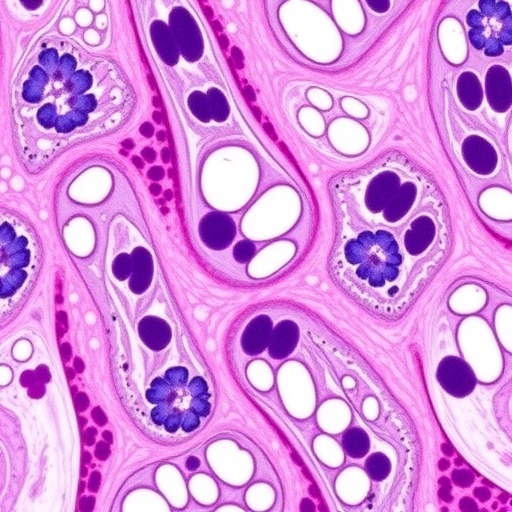In a groundbreaking development poised to reshape our understanding of infectious bacterial mechanisms, scientists have unveiled critical molecular components responsible for the hemolytic activity of Bartonella bacilliformis, the pathogen behind the life-threatening Carrión’s disease. The new study identifies two proteins, Porin A and an α/β-hydrolase enzyme, as both necessary and sufficient for the destruction of red blood cells, a finding that could catalyze transformative advances in therapeutic strategies and diagnostic approaches.
Bartonella bacilliformis is a fastidious, vector-borne bacterium transmitted by sandflies in endemic regions of South America. The pathogen exhibits a peculiar and devastating ability to induce hemolysis, the rupture of red blood cells, leading to severe anemia, immunosuppression, and often fatal complications without prompt treatment. Despite the clinical significance, the precise molecular mechanism facilitating this hemolysis remained enigmatic until now.
By employing advanced molecular biology techniques and high-resolution structural analyses, researchers uncovered that Porin A, a membrane channel-forming protein, and an associated α/β-hydrolase enzyme cooperate intricately to mediate hemolytic activity. This discovery confers a mechanistic model where Porin A facilitates the translocation or interaction of the hydrolase enzyme with host erythrocyte membranes, orchestrating a precise sequence of molecular disruptions culminating in cell lysis.
The study meticulously characterized Porin A, demonstrating its ability to form pore-like structures in lipid bilayers resembling those of human erythrocytes. These pores appear to be fine-tuned to allow the specific entry or positioning of α/β-hydrolase, effectively turning the red blood cell membrane into a vulnerable target. The hydrolase’s enzymatic activity then degrades essential lipid components, compounding membrane instability and ultimately provoking hemolysis.
Biochemical assays revealed that neither Porin A nor the α/β-hydrolase alone could recapitulate hemolytic activity in vitro, underscoring a synergistic necessity. When combined, however, these proteins manifested robust lytic effects indistinguishable from those caused by whole bacteria, fulfilling sufficiency criteria. This duality highlights a sophisticated bacterial strategy that bypasses the need for additional virulence factors.
On a cellular level, the interaction disrupts the delicate architecture of the erythrocyte membrane cytoskeleton. Fluorescent microscopy elucidated that bacterial components preferentially localize at membrane microdomains enriched in cholesterol and sphingolipids—lipids essential for maintaining the mechanical resilience of red blood cells. The enzymatic assault by the α/β-hydrolase compromises these regions, rendering the cells increasingly susceptible to rupture under circulatory shear stress.
At the host-pathogen interface, these findings could explain the rapid progression from asymptomatic infection to hemolytic anemia observed clinically. The components identified act early in infection, facilitating bacterial survival and dissemination by disabling the host’s oxygen transport capacity. This molecular insight offers fertile ground for developing targeted inhibitors that neutralize either Porin A or the hydrolase enzyme, potentially halting disease progression before systemic complications arise.
Moreover, the data suggest possible avenues for diagnostic innovation. Detecting the presence or elevated activity of these proteins in patient blood samples might provide early biomarkers, enabling more timely intervention. This could be particularly impactful in remote endemic areas where diagnostic resources are limited.
The research also raises evolutionary questions regarding bacterial adaptation. Porin proteins are ubiquitous among Gram-negative bacteria; however, the specific coupling with an α/β-hydrolase to facilitate hemolysis appears unique to Bartonella bacilliformis. This specialization likely reflects selective pressure to evade host immune defenses and exploit the erythrocyte niche as an intracellular reservoir, facilitating chronic infection cycles.
In-depth structural data from cryo-electron microscopy unveiled how Porin A assembles into trimers forming stable, gated channels. The α/β-hydrolase, structurally related to esterases and lipases, appeared remarkably substrate-specific, targeting phospholipids prevalent in the outer leaflet of erythrocyte membranes. These findings pinpoint critical catalytic residues as pharmacological targets to prevent enzyme activity.
Clinically, Carrión’s disease presents a biphasic illness: an acute hemolytic phase and a chronic vasculoproliferative phase. Understanding the hemolytic machinery marks a pivotal step toward interrupting the acute phase, which is responsible for most morbidity and mortality. The study’s implications extend beyond B. bacilliformis, for hemolytic mechanisms are a common pathogenic strategy among bacterial species, offering a blueprint for exploring hemolysin function in diverse pathogens.
The multidisciplinary approach combined genomic, proteomic, and biophysical techniques to validate the hemolytic role of these proteins, underscoring modern infectious disease research’s increasingly integrative nature. High-throughput mutagenesis defined essential regions within Porin A and α/β-hydrolase, while in vivo infection models confirmed the attenuated virulence of strains lacking either protein, confirming their indispensable role.
From a therapeutic development standpoint, small molecule inhibitors or neutralizing antibodies designed to block Porin A pore formation or hydrolase enzymatic activity could represent viable interventions. Furthermore, vaccines eliciting antibodies against these proteins might confer protective immunity by preventing erythrocyte lysis.
The discovery also reframes our understanding of hemolytic strategies, emphasizing that membrane disruption can be a cooperative effort between channel-forming proteins and enzymatic lipases, rather than simple pore formation alone. This complexity enriches the conceptual landscape of bacterial pathogenic tactics and suggests the existence of analogous systems in other pathogens, waiting to be uncovered.
In summary, the identification of Porin A and α/β-hydrolase as the core drivers of Bartonella bacilliformis-induced hemolysis is a monumental stride forward in infectious disease biology. This knowledge unlocks new experimental and therapeutic pathways, promising to alleviate the burden of Carrión’s disease and informing broader bacterial pathogenesis studies. As research progresses, the possibility of wiping out hemolysis-driven pathology across various diseases comes tantalizingly closer to reality.
Subject of Research: The molecular mechanism of hemolysis caused by Bartonella bacilliformis involving Porin A and α/β-hydrolase.
Article Title: Porin A and α/β-hydrolase are necessary and sufficient for hemolysis induced by Bartonella bacilliformis.
Article References: Dichter, A.A., Winklmeier, F., Munteh, D. et al. Porin A and α/β-hydrolase are necessary and sufficient for hemolysis induced by Bartonella bacilliformis. Nat Commun (2025). https://doi.org/10.1038/s41467-025-66781-x
Image Credits: AI Generated
Tags: advanced structural analyses in microbiologyBartonella bacilliformis hemolysisCarrión’s disease pathogenesisdiagnostic approaches for Bartonella infectionsinfectious disease molecular mechanismsmolecular biology techniques in researchPorin A protein functionred blood cell destruction mechanismsandfly transmission of pathogenstherapeutic strategies for hemolytic anemiavector-borne bacterial infectionsα/β-hydrolase enzyme role





